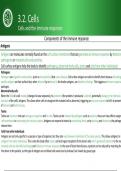3.2. Cells
Cells and the immune response:
Components of the immune response:
Antigens
Antigens are molecules normally found on the cell surface membrane that can generate an immune response by detectin
pathogenic or mutated cells and particles.
Cell surface antigens help the body to identify pathogens, abnormal body cells, toxins and cells from other individuals:
Pathogens:
Pathogens are organisms and particles (such as viral particles) that cause disease. Cell surface antigens are able to identify them because all pathog
specific antigens on their surface that, when detected by or bound to the bodies antigens, are labelled as foreign. This triggers an immune response
pathogen.
Abnormal body cells:
When the DNA of a cell mutates (changes its base sequence), its proteome (the proteins it produces) is altered, potentially changing the chemical a
structure of the cells’ antigens. This allows other cells to recognise the mutated cell as abnormal, triggering an immune response to kill it to prevent
of tumours and faulty tissues.
Toxins:
Toxins are chemicals that can damage an organism and its cells. Toxins can be released by pathogens such as bacteria, these can have effects rangin
cells membrane to interrupting the nervous system. Antigens can respond to toxins by neutralising them, or by locating and destroying the pathoge
release them.
Cells from other individuals:
Antigens are not only specific to a species or type of organism, but they also vary between individuals of the same species. This allows antigens to id
antigens from other individuals. This is why the body often rejects cell and organ transplants from donors who aren’t genetically identical to the rec
donated cells are identified as foreign and initiate an immune response. In the case of blood transfusions, rejection can be reduced by matching the
the donor to the patient, as the type of antigens on red blood cells varies less by induvial, but heavily by group type.
, 3.2. Cells
Cells and the immune response:
Components of the immune response:
White blood cells
White blood cells are a key component of the immune response, carried in the blood stream. There are many types of wh
each with their own role within the immune system.
Phagocytes: B-cells/B-lymphocytes:
Phagocytes are a type of white blood cell responsible for carrying out B-cells are white blood cells in the humeral immune res
phagocytosis in the non-specific immune response. Phagocytes are are covered in antibodies that can bind to foreign cells
some of the first cells to act in the immune response, and help to cause agglutination, immobilising the cell to make phag
activate later cells in the response. easier and prevent further damage or reproduction. Aft
T-cells/T-lymphocytes: an antigen and detecting the chemical signals released
T-cells are another type of white blood cell, and are a part of the cells can differentiate into plasma cells to produce and
specific immune response. T-cells act in the cellular immune response monoclonal antibodies into the blood stream to bind to
once activated by phagocytes. Activation is triggered when antigen- cells with complimentary antigens.
presenting cells (like phagocytes) bind to complimentary proteins on Effector B-cells are generic B-lymphocytes that are activated by
the T-cell membrane. to differentiate into plasma cells
Helper T-cells (TH) are one type of T-cells that release chemicals signals to Plasma cells are B-cells that can produce antibodies
stimulate further phagocytosis and activate cytotoxic T cells and B-cells. Memory B-cells store the genes needed to make antibodies co
Cytotoxic T-cells (TC) kill foreign and abnormal cells. a specific antigen. They stay in the blood stream much longer t
Memory T-cells memory T-cells ‘remember’ specific antigens so if they reinfect and can be activated and differentiated into plasma cells if the
the body in the future, the specific memory B-cells can quickly be activated reinfects the body.
, 3.2. Cells
Cells and the immune response:
Components of the immune response:
Antibodies
Antibodies are quaternary proteins that are complementary to a specific antigen. The specificity of an antigen is determin
3D structure which differs between proteins due to changes in the variable region.
Antigens are quaternary proteins made of 4 polypep
Variable regions linked by disulfide bridges. The two shorter chains a
Antigen binding
site chains, while the longer ones are called heavy chain
All 4 polypeptides have a constant region, which hav
amino acid sequence and secondary and tertiary str
antibodies.
Hinge region Variable regions
The chains also have variable regions found at the b
Light chains The variable regions differ between antibodies, and
Disulfide bridges structure that makes an antibody specific to its antig
On the heavy chains, there are regions called the hin
these sections can alter their bonding slightly to cha
between the two binding sites to allow the antibody
two antigens that are next to each other (e.g. on the
membrane) or that are further apart (e.g. the antibo
Heavy chains different cell membranes).
, 3.2. Cells
Cells and the immune response:
Components of the immune response:
Antibodies
Antibodies are quaternary proteins that are complementary to a specific antigen. The specificity of an antigen is determin
3D structure which differs between proteins due to changes in the variable region.
Antibodies are synthesised by B-lymphocytes and can be found free in the blo
tissue fluid, or on the surface of memory cells.
When a cell surface antibody binds to its complimentary antigen, the memor
holding the antigen is activated and a response is initiated- BM cells differenti
plasma cells, TM cells differentiate into TC cells
Antibody function:
Promoting phagocytosis- Antibodies coat pathogens, clumping them together to make
phagocytosis easier, as the phagocytes can bind to the antibodies and engulf connected
Cell lysis- Can work alongside other molecules to damage the cell membrane to cause
the cell.
Reducing mobility- Some antibodies can bind to a bacterial cells' flagellum, restricting
move around the body.
Neutralisation- Antibodies occupy the pathogens antigens and attachment proteins, ac
competitive inhibitor so the pathogen can’t enter and hijack the bodies cells.




